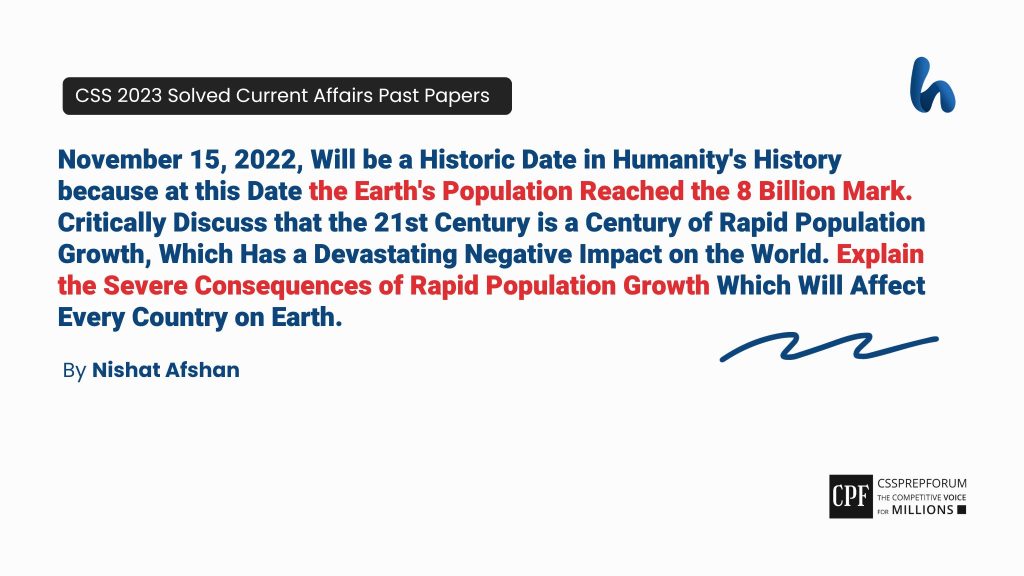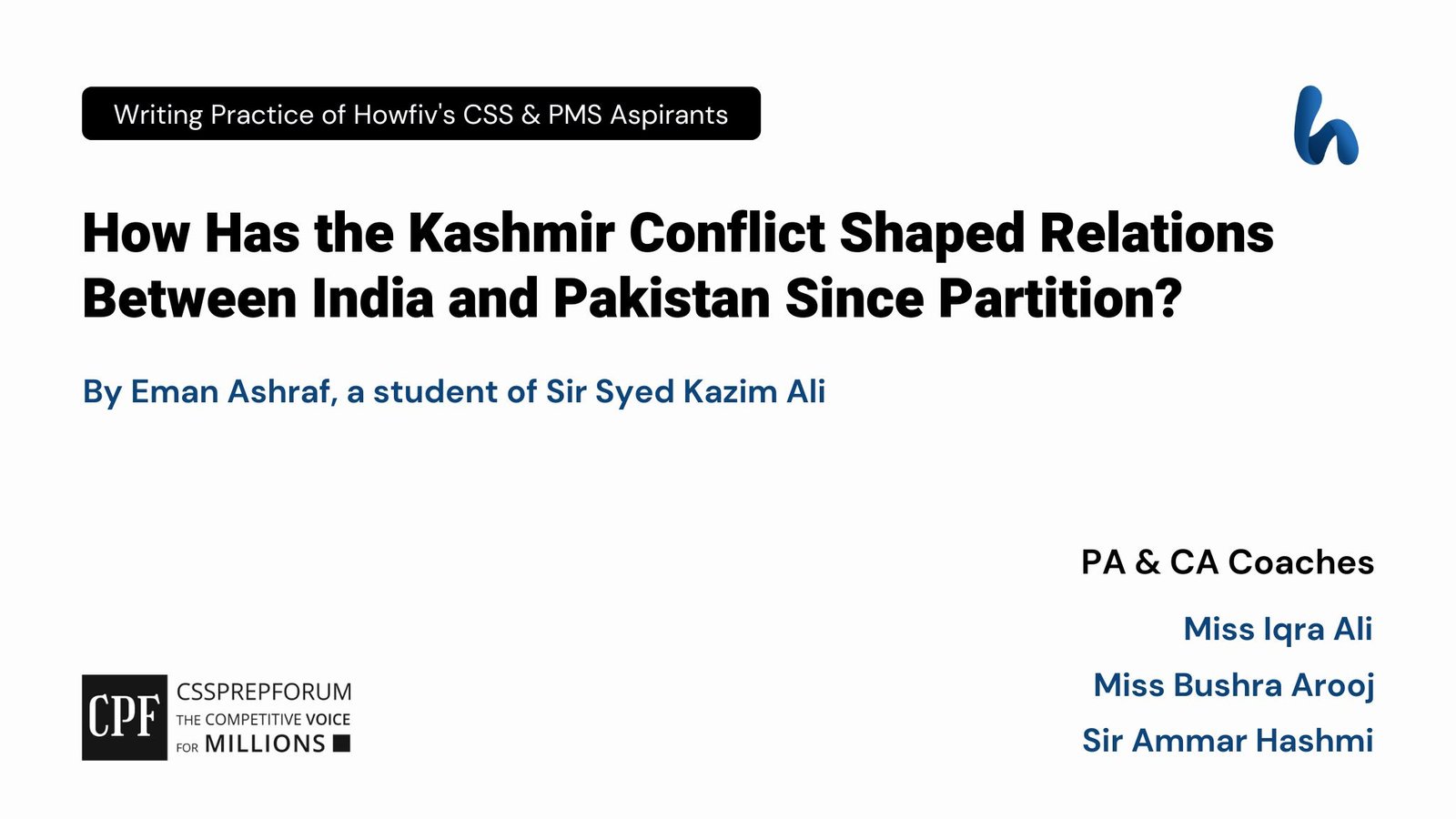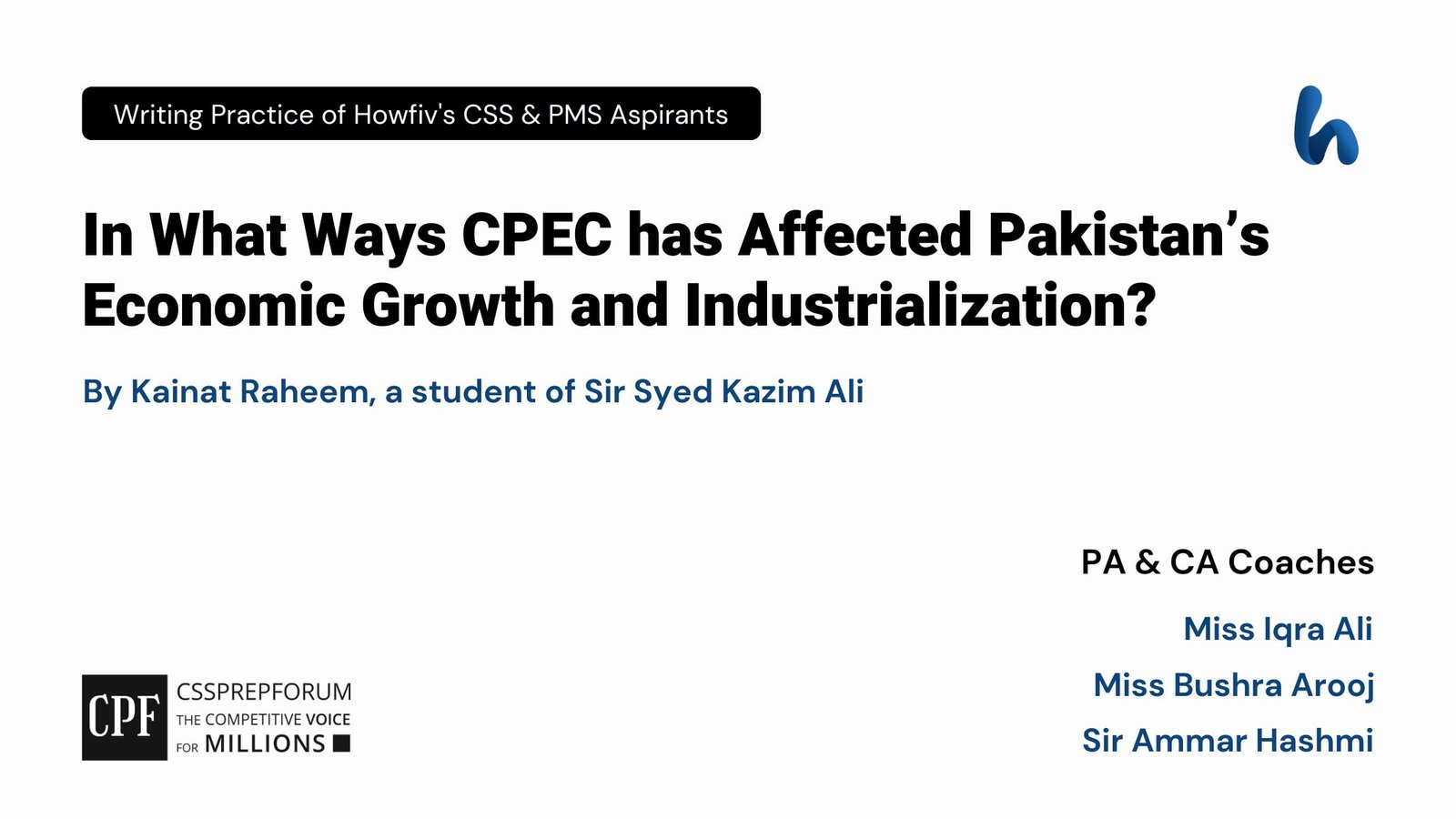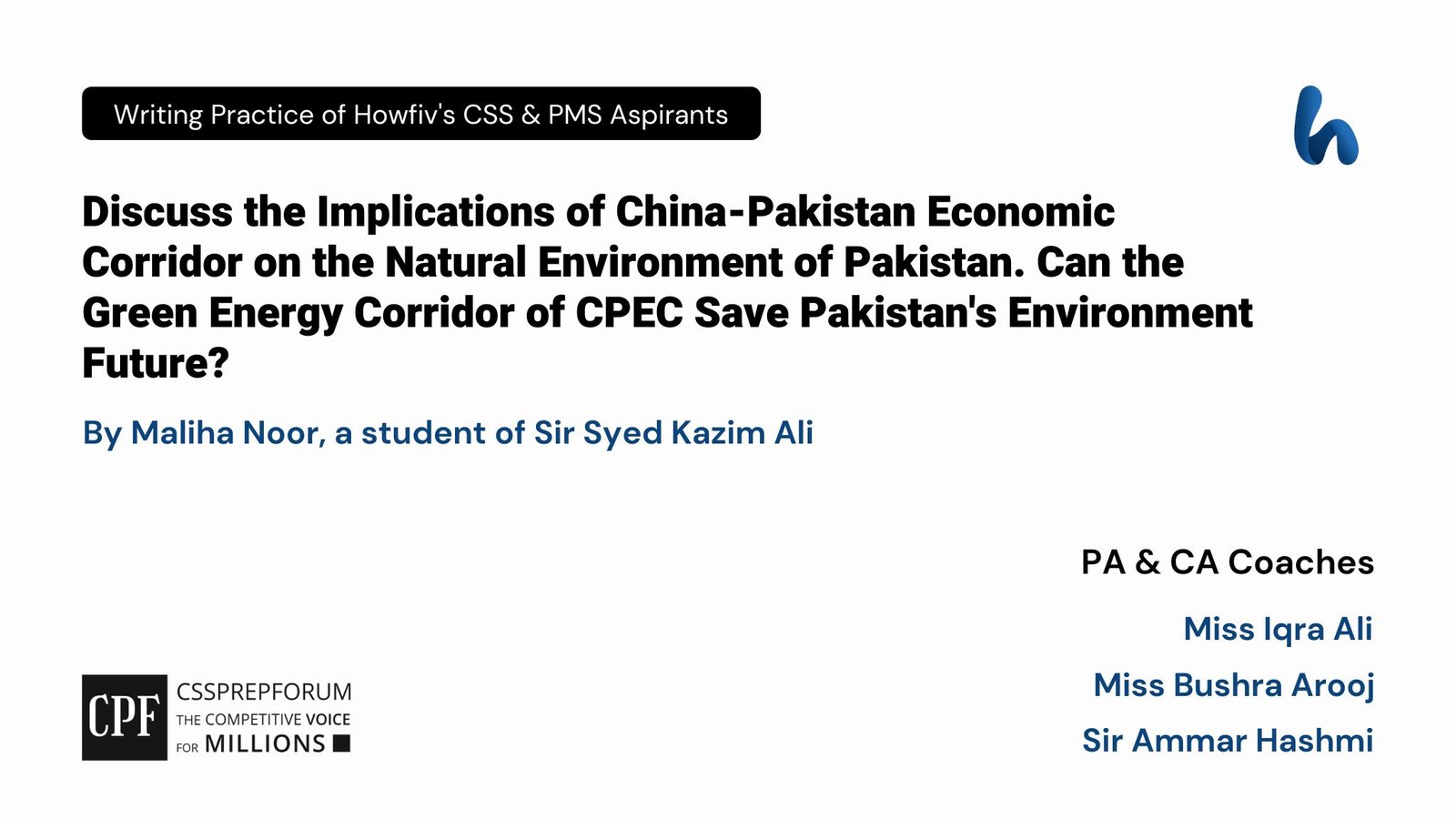CSS Solved Current Affairs Past Papers | November 15, 2022, Will be a Historic Date in Humanity’s History because at this Date the Earth’s Population Reached the 8 Billion Mark. Critically Discuss That the 21st Century is a Century of Rapid Population Growth, Which Has a Devastating Negative Impact on the World. Explain the Severe Consequences of Rapid Population Growth Which Will Affect Every Country on Earth.
The following question of CSS Current Affairs 2023 is solved by Nishat Afshan under the supervision of Miss Nirmal Hasni. She learnt how to attempt 20 marks question and essay writing from Sir Syed Kazim Ali, Pakistan’s best CSS and PMS English essay and precis teacher with the highest success rate of his students. This solved past paper question is attempted on the pattern taught by Sir to his students, scoring the highest marks in compulsory and optional subjects for years, and uploaded to help aspirants understand how to crack a topic or question, how to write relevantly, what coherence is, and how to include and connect ideas, opinions, and suggestions to score the maximum.

Question Breakdown
In this question, the examiner requires the negative impact of rapid population growth and its unswerving consequences given the earth’s population reached the 8 billion mark on 15 November 2022.
Outline
1- Introduction
2-Rapid Population Growth in the 21st Century: a pilot survey
3-Negative Impact of Rapid Population on the Globe
4-Severe consequences of Rapid population on countries across the world
5- Synthesis
6- Conclusion

Answer to the Question
Introduction:
The 21st century has witnessed unprecedented growth in the global population. While population growth is a natural phenomenon, the rate at which it has occurred in recent decades is alarming. One of the most significant consequences of rapid population growth is the strain it places on finite resources. As the population expands, the demand for resources such as food, water, energy, and land increases. This leads to overexploitation of natural resources, deforestation, habitat destruction, and pollution. The resulting environmental degradation threatens ecosystems, biodiversity, and exacerbation via food insecurity and malnutrition. Rapid urbanization leads to overcrowding, inadequate housing, and insufficient access to basic amenities such as sanitation, healthcare, and education. This situation implicates the devastating outcome of population perpetuation in case of neglect as the depletion of resources has already petrified the world with its aftermath. It poses challenges to infrastructure, economies, healthcare systems, and social stability. The consequences of rapid population growth also contribute to social and political instability, exacerbate climate change, and have far-reaching implications for global security. The population explosion has threatened the globe alarmingly with its apocalyptic impact by reaching the mark of 8 billion on 15 November 2022 which compels the global nations to take the necessary precautions to overcome the population chaos.
Rapid Population Growth in the 21st Century: a pilot survey:

The 21st century has witnessed an unprecedented surge in the global population. Factors such as advancements in healthcare, declining infant mortality rates, improved living conditions, and increased life expectancy have contributed to this exponential growth. The world’s population crossed the 7 billion mark in 2011 and is projected to reach 9.7 billion by 2050, according to the United Nations. Urbanization brings both opportunities and challenges, including strain on infrastructure, housing shortages, increased demand for services, and environmental pressures. Managing the growth of cities becomes crucial to ensure sustainable development. Resource scarcity leads to competition, conflicts, and inequities. Additionally, rapid population growth contributes to environmental degradation, including deforestation, habitat loss, pollution, and greenhouse gas emissions. This threatens biodiversity and ecosystems and exacerbates climate change. Demand for food continues to rise, necessitating increased agricultural productivity. However, the expansion of agriculture further leads to deforestation, soil degradation, and loss of biodiversity. Achieving global food security requires sustainable farming practices, innovation in agricultural techniques, and addressing issues of access and distribution. However, harnessing these opportunities requires robust economic policies, investments in education and skill development, and job creation. Failure to manage population growth and address the accompanying socioeconomic disparities can lead to high unemployment rates, income inequalities, and social unrest. Similarly, rapid population growth strains healthcare systems, particularly in developing countries. Ensuring access to quality healthcare, including reproductive healthcare and family planning, is crucial to address the health needs of a larger population and reduce maternal and infant mortality rates. On that wise, the population challenge has erupted into a sequel of multifaceted challenges and opportunities.
Negative Impact of Rapid Population on the Globe:
Rapid population growth in the 21st century has had significant negative implications for the entire globe. This elaboration aims to delve deeper into the adverse effects of rapid population growth on various aspects of human society and the environment. By understanding these impacts, we can work towards sustainable solutions to address the challenges posed by this global issue.

- 1- Resource Depletion and Environmental Degradation:
The exponential increase in the global population puts immense strain on natural resources. The demand for food, water, energy, and raw materials escalates, leading to overexploitation and depletion of finite resources. Moreover, rapid population growth contributes to environmental degradation, including deforestation, loss of biodiversity, habitat destruction, and pollution. This not only threatens ecosystems but also exacerbates climate change, leading to severe consequences such as extreme weather events and rising sea levels.
- 2- Food Insecurity and Malnutrition:
As the population expands, the challenge of feeding everyone becomes more daunting. Rapid population growth exacerbates food insecurity, particularly in developing countries with limited agricultural resources and inadequate infrastructure. The demand for food outpaces agricultural production, leading to higher prices and unequal distribution. This results in malnutrition, especially among vulnerable populations, causing long-term health issues and hindering socio-economic development.
- 3- Overburdened Infrastructure and Urban Challenges:
Rapid population growth leads to overcrowding, straining infrastructure in both urban and rural areas. In cities, the demand for housing, transportation, sanitation, and other essential services surpasses the capacity to provide them adequately. This results in inadequate living conditions, slums, traffic congestion, and increased pollution. In rural areas, the pressure on infrastructure such as roads, schools, and healthcare facilities limits access to vital services.
- 4- Economic Implications and Socio-economic Inequalities:
While rapid population growth can potentially drive economic growth, it can also lead to adverse economic consequences. High population growth rates can outpace job creation, resulting in high unemployment rates, particularly among the youth. The dependency ratio, the proportion of non-working individuals to the working population, increases, placing strain on social welfare systems. Additionally, rapid population growth exacerbates socioeconomic inequalities, as resources become scarce and disparities widen between different groups.
- 5- Strained Healthcare Systems:
The expanding population puts significant pressure on healthcare systems worldwide. Increased demand for healthcare services challenges the capacity of healthcare infrastructure and personnel, particularly in developing countries. Access to quality healthcare becomes a concern, leading to inadequate medical facilities, overwhelmed healthcare providers, and limited access to essential treatments and medications. This negatively impacts public health outcomes and hinders efforts to address emerging health issues effectively.
- 6- Social and Political Instability:
Rapid population growth can contribute to social and political instability on both local and global scales. High population densities, competition for resources, and socioeconomic disparities can fuel social unrest, migration pressures, and conflicts. These issues have implications for peace and security, disrupting communities and destabilizing regions. Furthermore, population growth can strain governance systems, making it challenging for governments to provide adequate services and address the needs of their citizens.
- 7- Water Scarcity:
Rapid population growth intensifies the demand for freshwater resources, leading to water scarcity in many regions. Increased water usage for drinking, agriculture, and industrial purposes can deplete water sources, particularly in arid and water-stressed areas. Water scarcity poses significant challenges for agriculture, sanitation, and hygiene, affecting public health and exacerbating socio-economic disparities.
- 8- Energy Demand and Climate Change:
A growing population necessitates increased energy consumption. However, reliance on fossil fuels to meet the rising energy demand contributes to climate change. Rapid population growth leads to higher greenhouse gas emissions, exacerbating global warming and its associated consequences such as rising temperatures, melting ice caps, and altered weather patterns. Transitioning to sustainable and renewable energy sources becomes crucial to mitigate these impacts.
- 9- Migration Pressures:
Population growth can trigger migration pressures, as individuals seek better opportunities or flee from regions with limited resources, conflicts, or environmental degradation. Mass migration poses challenges for both the origin and destination countries, straining resources, creating social tensions, and often resulting in humanitarian crises. Managing migration flows and addressing the root causes of migration become critical concerns.
- 10- Loss of Cultural and Indigenous Heritage:
Rapid population growth can contribute to the loss of cultural and indigenous heritage. As population centres expand and urbanization spreads, traditional cultural practices, languages, and customs can be marginalized or lost altogether. The preservation of cultural diversity becomes crucial to maintain social cohesion, promoting inclusivity, and safeguarding humanity’s collective heritage.
- 11- Pressure on Education Systems:
With a growing population, education systems face challenges in accommodating the increasing number of students. The demand for schools, teachers, and educational resources often outpaces the capacity to provide quality education. This can lead to overcrowded classrooms, limited access to education, and compromised educational outcomes, hindering human capital development and socio-economic progress.
- 12- Impact on Wildlife and Natural Ecosystems:
Rapid population growth encroaches upon wildlife habitats and natural ecosystems. As urbanization and infrastructure development expand, biodiversity-rich areas are often compromised or destroyed. This leads to the displacement and endangerment of wildlife species, disrupting ecological balance and diminishing the planet’s natural heritage.
Severe consequences of Rapid population on countries across the world:
The severe consequences of rapid population growth can vary between Eastern and Western countries due to different socioeconomic factors, cultural contexts, and levels of development.
Here’s an elaboration on the potential impacts in each region:
A- Severe Consequences in Eastern Countries:
- 1- Strained Infrastructure:
Rapid population growth in Eastern countries can put immense strain on already limited infrastructure, including transportation systems, housing, and utilities. The rapid urbanization seen in many Eastern countries can lead to overcrowded cities, inadequate housing, traffic congestion, and overstretched public services.
- 2- Economic Challenges:
Eastern countries may face economic challenges due to rapid population growth. The demand for jobs outpaces the available opportunities, leading to high unemployment rates, particularly among young people. The strain on public finances can limit investments in infrastructure, education, and healthcare, hindering economic development and exacerbating income inequalities.
- 3- Environmental Pressures:
Eastern countries with rapid population growth may experience significant environmental pressures. Increased demand for resources, including water and energy, can strain already limited supplies. Deforestation, pollution, and habitat destruction can intensify, contributing to biodiversity loss and exacerbating climate change. Environmental degradation can have far-reaching impacts on ecosystems, food security, and public health.
- 4- Healthcare System Strain:
Rapid population growth can overwhelm healthcare systems in Eastern countries, particularly those with limited resources. Insufficient healthcare infrastructure and a shortage of healthcare professionals can result in inadequate access to quality healthcare services. This strain on the healthcare system may lead to increased disease burdens and limited healthcare options, impacting public health outcomes.
B- Severe Consequences in Western Countries:
- 1- Aging Population and Dependency:
In Western countries with rapidly ageing populations, rapid population growth can exacerbate the challenges associated with an already high proportion of elderly citizens. A larger dependent population places strain on social welfare systems, pension funds, and healthcare services, leading to increased financial burdens and potential inadequacies in providing care for the ageing population.
- 2- Immigration Pressures:
Rapid population growth in Western countries can be driven by immigration pressures. The influx of migrants, particularly in regions with already strained resources, can pose challenges related to social integration, resource distribution, and cultural assimilation. The need for infrastructure, housing, and social services to accommodate a growing immigrant population can strain public resources and lead to social tensions.
- 3- Economic Opportunities and Labor Market:
Rapid population growth in Western countries can create opportunities and challenges within the labour market. The growing population can contribute to a larger consumer base and potential economic growth. However, managing the integration of a larger workforce into the labour market can be complex. Competition for jobs can increase, potentially leading to unemployment, income inequalities, and socio-economic disparities.
- 4- Healthcare and Social Welfare:
Western countries with rapid population growth face challenges in maintaining quality healthcare and social welfare systems. Increased demand for healthcare services, particularly from an ageing population, can strain healthcare infrastructure and increase healthcare costs. Meeting the growing demand for social welfare programs, including pensions and social support, can become financially burdensome.
Synthesis:
The 21st century has indeed witnessed rapid population growth, which has significant and far-reaching negative impacts on the world. The consequences of this phenomenon affect every country on Earth, exacerbating various challenges and creating new ones. The expanding population intensifies the demand for finite resources such as food, water, energy, and land. This leads to overexploitation, depletion, and environmental degradation, posing threats to ecosystems, biodiversity, and climate stability. Inadequate access to nutritious food results in malnutrition and related health issues, impacting the well-being of individuals and hindering socio-economic development. High population growth rates can lead to economic challenges such as unemployment, income inequalities, and strained social welfare systems. The dependency ratio rises, placing additional burdens on the working population and hindering economic progress. Similarly, expanding populations strain healthcare systems, particularly in countries with limited resources. Increased demand for healthcare services can overwhelm infrastructure, leading to inadequate access to quality healthcare, higher disease burdens, and public health challenges. It can fuel social unrest, migration pressures, and conflicts. Furthermore, this scenario intensifies climate change, with consequences such as extreme weather events, rising sea levels, and disruptions to ecosystems and livelihoods. By recognizing the gravity of these issues and taking appropriate measures, countries can work towards a sustainable future that ensures the well-being of both current and future generations.
Conclusion:
The Crux of the matter is that the 21st century has witnessed rapid population growth, which indeed has a devastating negative impact on the world. The severe consequences of this phenomenon extend to every country on Earth, exacerbating existing challenges and creating new ones. Rapid population growth strains resources, leads to environmental degradation, and intensifies food insecurity and malnutrition. It poses challenges to infrastructure, economies, healthcare systems, and social stability. The consequences of rapid population growth also contribute to social and political instability, exacerbate climate change, and have far-reaching implications for global security. Recognizing the gravity of these challenges is crucial. By actively addressing the severe consequences of rapid population growth, countries can strive towards a sustainable future that ensures the well-being of both present and future generations. It is imperative to understand that population growth is a complex issue influenced by a multitude of factors, and solutions must be tailored to the specific circumstances of each country. Through collective efforts, we can work towards a world where population growth is balanced, resources are managed sustainably, and the negative impacts on societies and the environment are minimized.
CSS Solved Past Papers’ Essays
Looking for the last ten years of CSS and PMS Solved Essays and want to know how Sir Kazim’s students write and score the highest marks in the essays’ papers? Then, click on the CSS Solved Essays to start reading them.
CSS Solved Essays
CSS 2023 Solved Current Affairs

Articles Might Interest You!
The following are some of the most important articles for CSS and PMS aspirants. Click on any to start reading.












